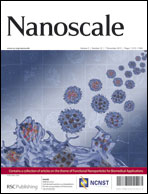A novel approach for measuring the intrinsic nanoscale thickness of polymer brushes by means of atomic force microscopy: application of a compressible fluid model†
Abstract
The thickness of a poly(sulfo propyl methacrylate) (PSPM) brush is determined by Atomic Force Microscopy (AFM) imaging as a function of the loading force at different ionic strengths, ranging from Milli-Q water to 1 M NaCl. Imaging is performed both with a sharp tip and a colloidal probe. The brush thickness strongly depends both on the applied load and on the ionic strength. A brush thickness of 150 nm is measured in Millipore water when applying the minimal loading force. Imaging with an 8 μm silica particle as a colloidal probe results in a thickness of 30 nm larger than that measured with the tip. Increasing the ionic strength causes the well known reduction of the thickness of the brush. The apparent thickness of the brush decreases with increasing loading forces. An empirical model analogous to that of a compressible fluid is applied to describe the dependence of the apparent thickness of the brush with loading force. The model comprises three ionic strength dependent parameters for the brush: thickness at infinite compression, energy, and cohesive force. The meaning and significance of these parameters are discussed. A particular advantage of the model is that it allows for determination of the brush thickness at zero loading force.


 Please wait while we load your content...
Please wait while we load your content...